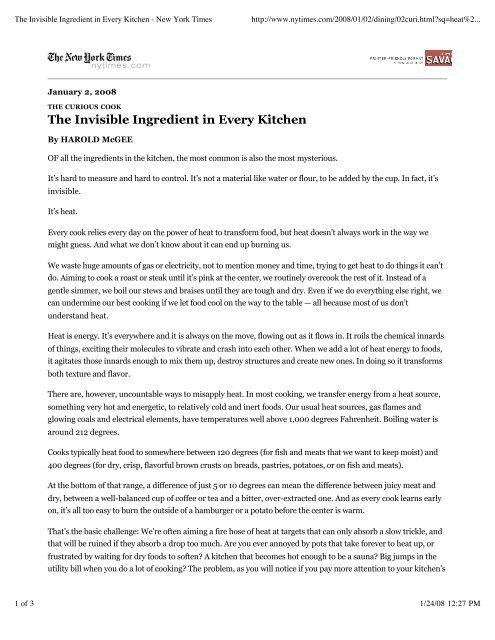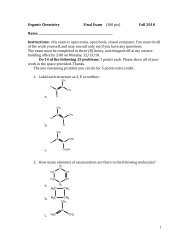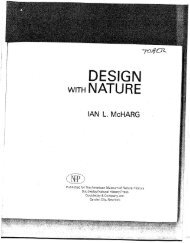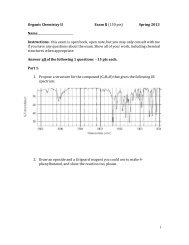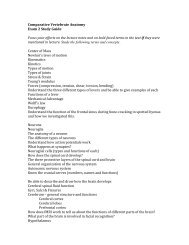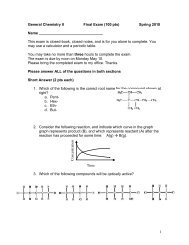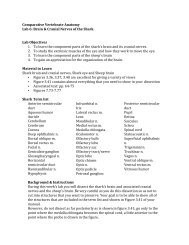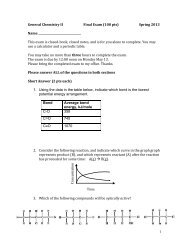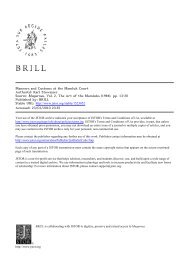The Invisible Ingredient in Every Kitchen - New York Times - Courses
The Invisible Ingredient in Every Kitchen - New York Times - Courses
The Invisible Ingredient in Every Kitchen - New York Times - Courses
You also want an ePaper? Increase the reach of your titles
YUMPU automatically turns print PDFs into web optimized ePapers that Google loves.
<strong>The</strong> <strong>Invisible</strong> <strong>Ingredient</strong> <strong>in</strong> <strong>Every</strong> <strong>Kitchen</strong> - <strong>New</strong> <strong>York</strong> <strong>Times</strong>http://www.nytimes.com/2008/01/02/d<strong>in</strong><strong>in</strong>g/02curi.html?sq=heat%2...January 2, 2008THE CURIOUS COOK<strong>The</strong> <strong>Invisible</strong> <strong>Ingredient</strong> <strong>in</strong> <strong>Every</strong> <strong>Kitchen</strong>By HAROLD McGEEOF all the <strong>in</strong>gredients <strong>in</strong> the kitchen, the most common is also the most mysterious.It’s hard to measure and hard to control. It’s not a material like water or flour, to be added by the cup. In fact, it’s<strong>in</strong>visible.It’s heat.<strong>Every</strong> cook relies every day on the power of heat to transform food, but heat doesn’t always work <strong>in</strong> the way wemight guess. And what we don’t know about it can end up burn<strong>in</strong>g us.We waste huge amounts of gas or electricity, not to mention money and time, try<strong>in</strong>g to get heat to do th<strong>in</strong>gs it can’tdo. Aim<strong>in</strong>g to cook a roast or steak until it’s p<strong>in</strong>k at the center, we rout<strong>in</strong>ely overcook the rest of it. Instead of agentle simmer, we boil our stews and braises until they are tough and dry. Even if we do everyth<strong>in</strong>g else right, wecan underm<strong>in</strong>e our best cook<strong>in</strong>g if we let food cool on the way to the table — all because most of us don’tunderstand heat.Heat is energy. It’s everywhere and it is always on the move, flow<strong>in</strong>g out as it flows <strong>in</strong>. It roils the chemical <strong>in</strong>nardsof th<strong>in</strong>gs, excit<strong>in</strong>g their molecules to vibrate and crash <strong>in</strong>to each other. When we add a lot of heat energy to foods,it agitates those <strong>in</strong>nards enough to mix them up, destroy structures and create new ones. In do<strong>in</strong>g so it transformsboth texture and flavor.<strong>The</strong>re are, however, uncountable ways to misapply heat. In most cook<strong>in</strong>g, we transfer energy from a heat source,someth<strong>in</strong>g very hot and energetic, to relatively cold and <strong>in</strong>ert foods. Our usual heat sources, gas flames andglow<strong>in</strong>g coals and electrical elements, have temperatures well above 1,000 degrees Fahrenheit. Boil<strong>in</strong>g water isaround 212 degrees.Cooks typically heat food to somewhere between 120 degrees (for fish and meats that we want to keep moist) and400 degrees (for dry, crisp, flavorful brown crusts on breads, pastries, potatoes, or on fish and meats).At the bottom of that range, a difference of just 5 or 10 degrees can mean the difference between juicy meat anddry, between a well-balanced cup of coffee or tea and a bitter, over-extracted one. And as every cook learns earlyon, it’s all too easy to burn the outside of a hamburger or a potato before the center is warm.That’s the basic challenge: We’re often aim<strong>in</strong>g a fire hose of heat at targets that can only absorb a slow trickle, andthat will be ru<strong>in</strong>ed if they absorb a drop too much. Are you ever annoyed by pots that take forever to heat up, orfrustrated by wait<strong>in</strong>g for dry foods to soften? A kitchen that becomes hot enough to be a sauna? Big jumps <strong>in</strong> theutility bill when you do a lot of cook<strong>in</strong>g? <strong>The</strong> problem, as you will notice if you pay more attention to your kitchen’s1 of 3 1/24/08 12:27 PM
<strong>The</strong> <strong>Invisible</strong> <strong>Ingredient</strong> <strong>in</strong> <strong>Every</strong> <strong>Kitchen</strong> - <strong>New</strong> <strong>York</strong> <strong>Times</strong>http://www.nytimes.com/2008/01/02/d<strong>in</strong><strong>in</strong>g/02curi.html?sq=heat%2...thermal landscape, even <strong>in</strong> terms of what you can feel, is how much heat escapes without ever gett<strong>in</strong>g <strong>in</strong>to thefood.Among the major culprits here are <strong>in</strong>efficient appliances. Accord<strong>in</strong>g to the United States Department of Energy,a gas burner delivers only 35 to 40 percent of its heat energy to the pan; a standard electrical element conveysabout 70 percent. Anyone th<strong>in</strong>k<strong>in</strong>g about kitchen renovation should know that <strong>in</strong>duction cooktops, whichgenerate heat directly with<strong>in</strong> the pan itself, are around 90 percent efficient. <strong>The</strong>y can out-cook big-B.T.U. gasburners, work faster, don’t heat up the whole kitchen, and are becom<strong>in</strong>g more common <strong>in</strong> restaurant kitchens.Maximiz<strong>in</strong>g the transfer of heat from burner to pot produces better food. In deep fry<strong>in</strong>g, the faster the burner canbr<strong>in</strong>g the oil temperature back up after the food is added, the quicker the food cooks and the less oil it absorbs. Inboil<strong>in</strong>g green vegetables, a fast recovery time means better retention of vibrant color and vitam<strong>in</strong>s.No matter how efficient an appliance is, the cook can help simply by cover<strong>in</strong>g pots and pans with their lids. Someof the heat that enters through the bottom of the pot exits through the top, but a lid prevents much of it fromescap<strong>in</strong>g <strong>in</strong>to the air. This is especially true when you’re br<strong>in</strong>g<strong>in</strong>g a pot of water to the boil. With the lid on, it willstart bubbl<strong>in</strong>g <strong>in</strong> as little as half the time. Turn<strong>in</strong>g water <strong>in</strong>to steam takes a lot of energy, and every molecule thatflies away from the water surface takes all that energy with it <strong>in</strong>to the air. Prevent its escape, and the energy stayswith the pot to heat the rest of the water.Once a liquid starts to boil and is turn<strong>in</strong>g to steam throughout the pot — the bubbles of a boil are bubbles of watervapor — nearly all the energy from the burner is go<strong>in</strong>g <strong>in</strong>to steam production. <strong>The</strong> temperature of the water itselfrema<strong>in</strong>s steady at the boil<strong>in</strong>g po<strong>in</strong>t, no matter how high the flame is underneath it. So turn the burner down. Agentle boil is just as hot as a furious one.Cook<strong>in</strong>g doesn’t get much more straightforward than boil<strong>in</strong>g and steam<strong>in</strong>g vegetables, gra<strong>in</strong>s, and the like. Butsometimes it takes forever, which either delays d<strong>in</strong>ner or results <strong>in</strong> crunchy beans and d<strong>in</strong>ers suffer<strong>in</strong>g for it later.And you can’t speed the process by rais<strong>in</strong>g the heat.In fact it’s easy to save loads of time and energy and potential discomfort with gra<strong>in</strong>s, dry beans and lentils, andeven pasta. But it requires a little th<strong>in</strong>k<strong>in</strong>g ahead. It turns out that the most time-consum<strong>in</strong>g part of the process isnot the movement of boil<strong>in</strong>g heat to the center of each small bean or noodle, which takes only a few m<strong>in</strong>utes, butthe movement of moisture, which can take hours. Gra<strong>in</strong>s and dry legumes therefore cook much faster if they havebeen soaked. However heretical it may sound to soak dried pasta, do<strong>in</strong>g so can cut its cook<strong>in</strong>g time by two-thirds— and elim<strong>in</strong>ates the problem of dry noodles gett<strong>in</strong>g stuck to each other as they slide <strong>in</strong>to the pot.<strong>The</strong> trickiest foods to heat just right are meats and fish. <strong>The</strong> problem is that we want to heat the center of the pieceto 130 or 140 degrees, but we often want a browned, tasty crust on the surface, and that requires 400 degrees.It takes time for heat to move <strong>in</strong>ward from the surface to the center, so the default method is to fry or grill or broiland hope that the brown<strong>in</strong>g time equals the heat-through time. Even if that math works out, the area between thecenter and surface will then range <strong>in</strong> temperature between 130 and 400 degrees. <strong>The</strong> meat will be overcookedeverywhere but right at the center.<strong>The</strong> solution is to cook with more than one level of heat. Start with very cold meat and very high heat to get the2 of 3 1/24/08 12:27 PM
<strong>The</strong> <strong>Invisible</strong> <strong>Ingredient</strong> <strong>in</strong> <strong>Every</strong> <strong>Kitchen</strong> - <strong>New</strong> <strong>York</strong> <strong>Times</strong>http://www.nytimes.com/2008/01/02/d<strong>in</strong><strong>in</strong>g/02curi.html?sq=heat%2...surface browned as quickly as possible with m<strong>in</strong>imal cook<strong>in</strong>g <strong>in</strong>side; then switch to very low heat to cook the<strong>in</strong>terior gently and evenly, leav<strong>in</strong>g it moist and tender.On the grill, this means hav<strong>in</strong>g high- and low-heat zones and mov<strong>in</strong>g the food from one to the other. On the stovetop or <strong>in</strong> the oven, start at 450 or 500 degrees, and then turn the heat down to around 250, ideally tak<strong>in</strong>g the foodout until the pan or oven temperature has fallen significantly.Another solution is to cook the food perfectly with low heat, let it cool some, and then flavor its surface with a briefblast of <strong>in</strong>tense heat from a hot pan or even a gas torch. More and more restaurants are adopt<strong>in</strong>g this method,especially those that practice sous-vide cook<strong>in</strong>g, <strong>in</strong> which food is sealed <strong>in</strong> a plastic bag, placed <strong>in</strong> a preciselycontrolled water bath and heated through at exactly the temperature that gives the desired doneness.All these are two-step processes, but the same pr<strong>in</strong>ciple works for three steps or more. Rotisserie cook<strong>in</strong>galternates high and low heat many times: as the meat turns on the spit, each area of the surface is briefly exposedto high brown<strong>in</strong>g heat, then given time for that dose of energy to dissipate, part of it <strong>in</strong>to the meat but part back out<strong>in</strong>to the cool air. So the meat <strong>in</strong>terior cooks through at a more moderate temperature. Similarly, steaks and chopscook more evenly on high grill heat — and faster as well — if you become a human rotisserie and turn them notonce or twice but as often as you can stand to, even dozens of times, every 15 or 30 seconds.Tough cuts of meat require longer cook<strong>in</strong>g to dissolve their connective tissue, and stew<strong>in</strong>g or slow brais<strong>in</strong>g <strong>in</strong> a lowoven is a simple and popular method of do<strong>in</strong>g so. But many recipes don’t give the best results, simply becausethey don’t take <strong>in</strong>to account the vast difference between cook<strong>in</strong>g with the lid on and off. Even <strong>in</strong> an oven set as lowas 225 or 250 degrees, if the pot is covered, the contents will reach the boil, and the meat will overcook and dryout.Leave the lid ajar or off, and evaporation of the cook<strong>in</strong>g liquid cools the pot and moderates the meat temperature,keep<strong>in</strong>g it closer to 160 to 180 degrees. This is hot enough to soften the connective tissue <strong>in</strong> a few hours withoutalso driv<strong>in</strong>g out most of the meat’s moisture.<strong>The</strong> challenge of heat management doesn’t end when you’ve cooked someth<strong>in</strong>g to perfection. How often have youfound that the dish that was perfect <strong>in</strong> the kitchen seems to have lost someth<strong>in</strong>g by the time you sit down and takethe first bite? That someth<strong>in</strong>g certa<strong>in</strong>ly <strong>in</strong>cludes heat.Heat knocks molecules at the surface of food <strong>in</strong>to the air where we can sniff them, so it <strong>in</strong>creases the aroma. Insidethe food, agitated molecules make sauces more fluid and hot meat more tender. And the sensation of a food’swarmth is satisfy<strong>in</strong>g <strong>in</strong> itself. <strong>The</strong> moment hot food is put on a plate, its heat energy beg<strong>in</strong>s to flow out <strong>in</strong>to thecooler surround<strong>in</strong>gs. Aromas fade, sauces thicken, fats congeal.So when you transfer heat’s handiwork from the kitchen to the table, take along some extra. Warm the plates toprolong the pleasure. And encourage everyone to sit down and eat it while it’s hot.Copyright 2008 <strong>The</strong> <strong>New</strong> <strong>York</strong> <strong>Times</strong> CompanyPrivacy Policy Search Corrections RSS First Look Help Contact Us Work for Us Site Map3 of 3 1/24/08 12:27 PM


